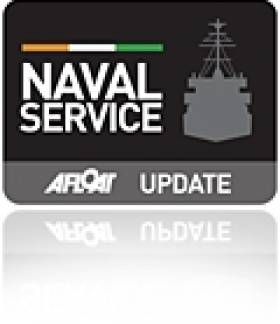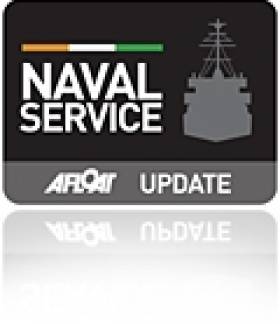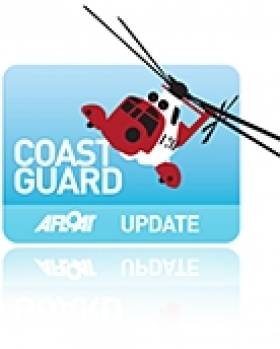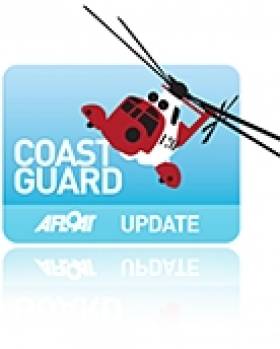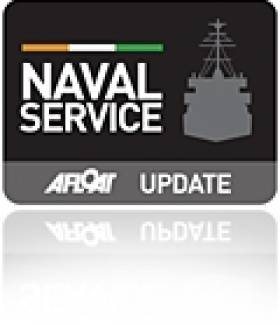Displaying items by tag: Navy
First Female Naval Commander Wins Inaugural Cork Woman of the Year Award
#NAVAL SERVICE-Lt Commander Roberta O'Brien, Ireland's first female commander of a Naval Service vessel, has been announced as the inaugural C Woman of the Year Award 2011.
In a ceremony held recently in the city's Imperial Hotel, over 90 women had been shortlisted for 18 categories and the overall C Woman of the Year 2011 was announced to the recipient.
The winning citation read:-The judges have decided that the recipient of the inaugural award for the C Woman of the Year awards 2011 is a woman who has brought exceptional pride to Ireland and to Cork, to women in all professions in Ireland and who has served her country with pride and distinction in the protection and safeguarding of our nation. A native of the Glen of Aherlow in Tipperary and based at Haulbowline island in Cork.
Lieutenant Commander Roberta O'Brien took command of L.E. Aisling (P23) at a ceremony held in the Offshore Patrol Vessels (OPV) adopted port of Galway in November 2008.
Creidne Sail Training Scheme
The Naval Service's Sailing Training Vessel Creidne cuts a great pose sailing in Cork Harbour on page three of the Autumn issue of Afloat. The refurbished 47-footer is now in full use by the Naval Service as a training vessel for naval personnel and is consequently a common sight sailing off the Haulbowline base.
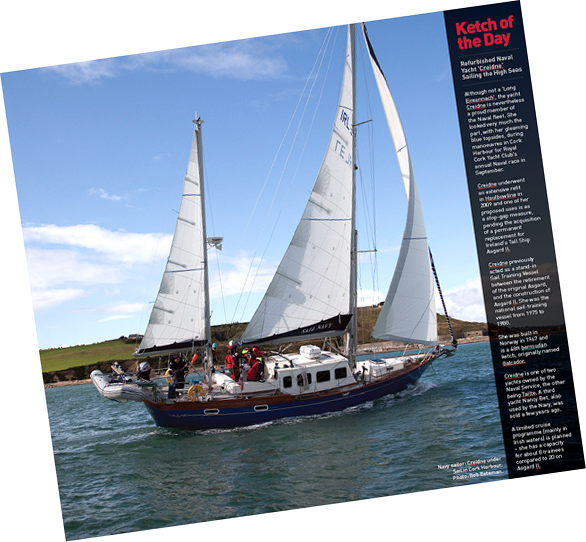
No Sail Training Programme because of Government cut backs
Although Creidne, built in 1967, undertook a limited sail training cruise programme in 2009, the programme was shelved when Creidne became a casualty of the Government's decision to discontinue the Sail Training Scheme operated by Coiste an Asgard. The Defence Forces have asked us to point out that the sail training programme, that took up to eight trainees, has been stopped even if the Autumn Afloat article may have given the impression that the Creidne is still carrying out this function. Apologies for any confusion.
Officer Cadetships in the Naval Service
The positions are Army Officers, Air Corps Officers (Pilot) and Naval Service Officers (Operations Officer or Engineering Officer). For further information including salary scale logon to www.military.ie/careers/officer
Applications for the 2011 Officer Cadet Competition are only being accepted online at www.military.ie and only from candidates who meet the minimum eligibility qualifications. Noting the closing date is 20 March 2011.
Robot Submarine to be Used in Joint Exercise off Cork Coast
A major marine search and recovery exercise co-ordinated by the Irish Coast Guard will to take place off the Cork coastline this week from 12-15 July 2010 it was announced today.
The exercise, in conjunction with the Marine Institute, the Commissioner for Irish Lights and the Navy, will simulate some major emergency situations including an aircraft crash, recovery of the 'Black Box'. The simulation exercise will also involve deep diving operations and the seeking and survey of a wrecked vessel. It will also incorporate the recovery of items such as ditched contraband and the rendering safe of underwater explosives.
A Service Level Agreement between the Irish Aviation Authority and the Irish Coast Guard was agreed in February of this year. It was agreed that should an aircraft force land in a maritime area, the IAA's Air Rescue Coordination Centre (ARCC) would be responsible for determining the initial search area, but co-ordination shall then transfer to the Coast Guard with continued close co-operation and back-up services from ARCC. As a result of this it was seen that there would need to be close cooperation between all the different agencies and authorities in responding to such a scenario. One of the most important aspects of an aircraft incident investigation is the location and recovery of the aircraft's 'black box'. The Coast Guard, as part of an Agreement with Commissioner of Irish Lights, has chartered their vessel ILV Granuaile, to act as a marine platform for Naval Divers and Holland 1, the Marine Institute's robot submarine a Remotely Operated vehicl e (ROV).
Holland 1 and the Navy Dive Team will be deployed from ILV Granuaile. Primarily used in maintenance of Aids to Navigation the ILV Granuaile is a sophisticated multi functional vessel whose 80-metre length, 16 metre and Dynamic Positioning capability make her an ideal platform for this task. The naval vessel L.E. Eithne will be on site for the duration of the exercise with its Commanding Officer acting as on-scene co-ordinator. The L.E. Eithne will act as the under water crisis management centre for all the personnel involved in the exercise, including the eighteen person naval diving team and the ROV operators and Coast Guard personnel.
Speaking today, Minister Noel Dempsey TD said: "The purpose of this joint exercise is to ensure and examine the level and quality of preparedness in the Irish Coast Guard response and that of our intra-agency partners. Simulations such as are a valuable way to test our co-ordinated emergency response to ensure that in the event of a major emergency, that the appropriate and necessary measures are in place in search, rescue and recovery."
Minister of Defence Mr. Tony Killeen T.D., said that "through Inter Agency co-operation and establishing appropriate protocols for joint exercises we can ensure our ships and our divers are ready to respond in an appropriate and timely manner for given situations."
"While the ROV Holland was acquired primarily as a research vessel, another key function is to provide the capability to assist underwater search and recovery operations," said Mr. Sean Connick, T.D., Minister of State at the Department of Agriculture, Fisheries and Food. "We are therefore delighted to take part in this important exercise, which will involve a combined national ROV team piloting the Holland 1 operated by Naval and Marine Institute pilots."
Holland 1 and Granuaile are available for inter agency work as part of Service Level Agreements between the various parties which promote inter-agency cooperation and the up-skilling of personnel in each organisations for collaborative operations.
Graduation Ceremony at National Maritime College of Ireland
The NMCI, Ireland's only purpose built Maritime Training Centre, and a constituent college of CIT will, tomorrow afternoon, host the conferring of graduates in Ringaskiddy, Co. Cork.
For the first time in the history of the Naval Service and the Defence Forces, a full Level 7 (NFQ), Ordinary Degree in Leadership, Management & Naval Studies will be awarded to 13 Non-Commissioned Officers in recognition of their completion of the NS Senior NCOs Course and ancillary Modules.
The June graduation ceremony is highly significant in the context of military training and education and is the culmination of a five-year intensive project that has secured external accreditation for the training and education undertaking by all ranks. The Naval Service of today offers major awards under the National Framework of Qualifications for its training and education programmes.
The graduation ceremonies will take place at 1500 hrs on Thursday 17 June at the National Maritime College of Ireland (NMCI), Ringaskiddy.
Air Corps Patrol Makes Emergency Landing
LE Aoife Heading for Major Repairs
The LE Aofie will be taken in for routine maintenance next month which will involve major repairs according to Sunday Tribune reporter Ken Foxe. More than 250,000 Euro was spent on repairs to LE Emer and LE Aoife after holes were found in the ships last summer. The damage was believed to have been caused by ocean conditions, primarily sailt water erosion.
Click here for the full report.
Welcome to Afloat TV

Since 2003 the team behind Afloat magazine has also been producing high-end, internationally appealing and entertaining factual documentaries on the Irish waterways. The production team are a mix of creative, technical and business people whose expertise guarantees an innovative approach to production and a high-quality finished product. The focus is on marine based programmes which entertain and educate. The work has been broadcast on RTE One and internationally on Sky Channels.
The Bay
Screened on RTE One in 2005.
Take a trip around the one half of Ireland's capital city you probably know the least. A new four-part documentary series, The Bay will be screened over four consecutive Wednesdays in May. Using spectacular aerial and underwater footage, the series features a combination of personality-led interviews and themes to tell the story of Dublin's unique waterway. Dublin Bay stretches over six kilometres, from Howth Head on its northern tip to Dalkey Island in the south. It's a place most Dubliners simply take for granted, and one of the capital's least visited places. But there's more going on out there than you'd imagine. And that's why The Bay was made. The series introduces viewers to the rich diversity of activities and personalities around the bay, while also touching on the serious environmental and political issues facing it. Find out more about the bay here.
The Harbour
Screened on RTE One in 2007.
It’s one of the largest natural harbours in the world – and those living near Cork Harbour insist that it’s also one of the most interesting. This was the last port of call for the most famous liner in history, the Titanic, but it has been transformed into a centre for chemical and pharmaceutical industry. Giraffe wander along its shores, from which tens of thousands of men and women left Ireland, most of them never to return. The harbour is home to the oldest yacht club in the world, and to the Irish Navy. This deep waterway has also become a vital cog in the Irish economy. ‘The Harbour’ is not a history programme, nor is it a news focus. It’s simply an exploration of this famous waterway, its colour and its characters. Find out more about the harbour here.
The Estuary
Screened on RTE One in 2007.
The story of the Shannon estuary might well be one of neglect, except that against the odds this waterway has become one of Ireland's greatest natural resources. Windswept, sitting on the edge of the Atlantic, often ignored by the nation. The story of the Shannon estuary might well be one of neglect, except that against the odds this waterway has become one of Ireland's greatest natural resources. A new four-part documentary series, from the makers of RTÉ's The Bay and The Harbour series, uncovers the secrets of the Shannon Estuary. From flying boats to film-making, wildlife to wind-farms, the series reveals how a 100km-stretch of the Shannon waterway has become a hotbed for innovation in Ireland. Up to 40% of Irish energy needs are met here, on the shores of a waterway that is also home to Ireland's second largest airport, a 10,000 student university and a massive cargo port. Ireland - and the world - has learned from the estuary. The first duty free shop was opened here, along with the first industrial free zone. Over the years, thousands of business and political leaders from across the globe have come to Shannon to discover its secret - in the hope that they might copy it. Long before Ireland heard of green energy, this place was producing it. Listen in to dolphin conversations beneath the Shannon's waterline. Uncover the mystery of the Ark, the church on wheels built by a priest who prayed when the tide went out. Narrated by Brenda Fricker, the series aired on Friday nights at 7.30pm on RTÉ One from May 4th 2007. Find out more about the estuary here.
The Navy
Screened on RTE One in 2007.
60 years of the Irish Naval Service. Celebrating the 60th anniversary of the Irish Naval Service, this 3 x half-long feature documentary shows how the Service has evolved into a multi-tasking, multi-disciplinary force. Most Irish people rarely come into contact with the Naval Service, and so are unaware of the range of activities it undertakes. This documentary provides an ideal opportunity to reveal the full extent of the Service’s duties – and the commitment of those who serve on Ireland’s fleet.
The Regattas
Screened on RTE One, 2007 and Sky Sports in 2009.
Sailing featured in RTE’s Christmas schedules this year, with the broadcast of a half-hour documentary feature on the Volvo Dun Laoghaire Regatta 2007. The production, entitled ‘The Regatta’, was shot over four days in Dublin Bay during this year’s regatta. Made by Baily Films, the company behind earlier critically-acclaimed water-based documentaries The Bay, The Harbour, The Estuary and The Navy, it features spectacular on-board footage from a range of craft competing in the event. The Regatta takes viewers both on board the competing craft, and behind the scenes, to examine the challenges thrown up by organising such a large-scale event on the bay. The Regatta was broadcast on RTE 1 on Saturday, December 22, at 4.20pm.
IN DEVELOPMENT
Afloat TV projects at an advanced stage of development include:
The Edge of Ireland
Ireland’s attitude to the seas that surround her is one of the most curious in the world. An island nation, with more coastline than most other European nations, most of her citizens look inland.
Yet no-one in Ireland lives further than 100 kilometres from the sea, and the majority of the population are housed within 10 kilometres of the coast.
More than any other European nation, our history is written on our shores. The very first settlers clung to it, fearing to explore inland. The shores fed and sustained them, and continued to sustain communities from Malin Head to Mizen Head for the next 9,000 years.
From the fort of Dun Aengus to the fields at Carnsore Point, from Inishvickillane to Bull Island, the coastline holds a key to our understanding of Ireland and ourselves.
The Edge of Ireland will uncover that hidden history of Ireland, and explore what the future holds for our coastline. Travelling around the coast, it will use local and national experts to relate individual accounts of how the sea has connected with the land to shape a local community or the nation at large.
The six half-hour series will be presented thematically, rather than using a linear journey up and down the coastline.
CONTACT
If you're keen on promoting Ireland's waterways and would like to get involved with Afloat TV please email us here.


























